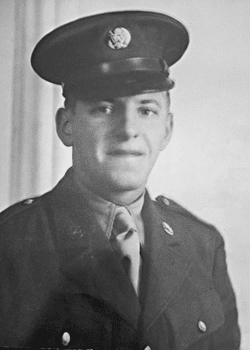

By Ryan Matthews
As November 11 approaches, it behooves us all to acknowledge the sacrifices that have been made by our service men and women. Many of them have given the ultimate sacrifice of losing their lives in the service of our great country.
While at times we take our liberties for granted and lose sight of those who defended our freedoms, our heroes must never be forgotten!
With that in mind, I submit the story of Private Edward Dabulas.
•
In the early morning hours of February 14, 1924, Anna Dabulas gave birth to a healthy 7-pound baby boy. He was their third child, a welcomed first son to her husband, Andrew. He would be named Edward Andrew Dabulas.
That morning, the winds swirled with blinding snow as Andrew walked from their house on Blair Street to hop on the open-air trolley. The hospital was located downtown in the city of Scranton, Pennsylvania. This was coal country, and the tunneled peaks adjacent to the city was where Andrew worked alongside the other cave workers. He managed seven coal cars and the laborers, which afforded his family economic stability.
The post-World War I boom of more mechanized industries had created increased demand for coal, and the coal veins of the Lackawanna mines had become an economic lifeline and a major employer of many in the neighboring communities.
The fuel was abundant in the hills of the Poconos. It was manually dug out of the surrounding mountains by miner’s picks and shovels, then hand-loaded onto the coal cars.
This was risky work, with the looming possibility of a dangerous collapse, mine fires and floods. All were ever-present fears of the men entering the mines, their silhouettes vanishing into the dark passage of uncertainty.
As Andrew held his son for the first time, he held a secret wish that his son would have a better way of life, a livelihood outside of the mines that would offer his son a brighter future than he had had as an immigrant.
Andrew Dabulas was my great-grandfather. An immigrant from Lithuania, his name is listed among the millions who had come to America through Ellis Island.
Andrew would eventually be father to a total of seven children, four girls and three boys. The girls played with baby Edward as if he were a human doll.
Sadly, those early days of the girls and their mother doting on Edward would come to a sudden end.
One November morning, Anna sent Lilly, who was 7, off to school, and she bathed and fed the two younger children. The cold fall mornings were spent at the kitchen table, huddled in front of the wood-burning stove.
Suddenly, without warning, Anna fell ill with a throbbing headache, collapsing to the floor. Her two toddlers were found hours later, wet and crying. Anna was found unconscious and unresponsive.
Lilly was told when she came home from school. Anna lingered for five days, then finally succumbed to a brain bleed. She would be waked at home for three days. Lilly still remembers the purple bunting wrapped around the twig wreath on the front door.
Two years later, Andrew married Jennifer Tate, an arranged match. The pair were introduced by church members. It was a marriage of convenience. Jennifer had been recently widowed, bringing two children into the fold. Andrew was a suitable provider, 20 years her senior. Jennifer was a stout, robust women capable of managing the household. Their union would produce two additional children, making a blended brood of seven.
Edward was the eldest son, and he attended high school through the 10th grade. He was a lanky kid, with sandy hair and hazel eyes; baseball was his passion.
He was otherwise shy, even a little socially awkward. His stepmother, Jennifer, was the only mother he remembered. She raised him dutifully, however lacking the maternal love she showered on the children she bore.
After finishing high school, Edward found work with the Civil Conservation Corps to help his family. His father’s health was failing; he later showed symptoms of black lung disease.
“Edward, I wanted a better life for you. I don’t want you stuck here working in the mines,” Andrew said, coughing several times as he talked.
The Depression had been devastating for blue-collar workers. The ability of a young man with no skills to find gainful employment was nil.
“I know, Father. I don’t think the mines hold much opportunity,” Edward told his father. Clearly, his father’s declining health was not symbolic of a bright future working in the mines.
The CCC was a public works program that ran from 1933 to 1942. Edward’s search for employment would end on September 2, 1942. He was 18 when he enlisted for military service at the Wilkes-Barre, Pennsylvania, office for the U.S. Army.
He ultimately would be assigned to Company C of the 601st Tank Destroyer Battalion. The unit initially saw action when their Reconnaissance Company landed at Oran, Algeria, Africa, on November 8, 1942, as part of Operation Torch. The rest of the battalion arrived there in December.
They fought in the battle of Kasserine Pass in February 1943, and at El Guettar in March 1943, under Lieutenant General George Patton.
Private Edward Dabulas celebrated his 19th birthday in North Africa. On June 7, 1943, postmarked from Bizerte, Tunisia, Edward mailed his sister a postcard. He wrote and thanked his sister for her letters she had sent and said he was grateful hearing that everything back home in Pennsylvania was all right.
His sister had decided not to tell him that their father had passed a few weeks earlier, on Mother’s Day.
Edward’s unit converted to the M10 Tank Destroyers command at the end of the North Africa Campaign. The unit converted before they participated in the invasion, landing at Salerno, Italy, on September 9. They made their assault at Anzio on January 22, 1944, and entered Rome that June.
It was while the unit was in Italy that Edward was injured, and he received his first Purple Heart. Edward recovered and was able to rejoin his unit when they landed in southern France on August 15.
A few days later, on August 19, 1944, Company C was involved in action in the vicinity of Brignoles, France. The Germans had a number of anti-tank guns set up in town, and casualties were heavy on both sides. Pfc. Edward Dabulas was injured by shell fragments and suffered severe burn wounds, and was evacuated to a field hospital for treatment. Sadly, four days later, on August 22, 1944, he died of his injuries.
He was posthumously awarded the Oak Leaf Cluster, denoting his second Purple Heart. He was initially buried in the American Military Cemetery in Luynes, France.
Shortly after the war ended, at the request of his sister, Lilly, he was re-interred in the Long Island National Cemetery in Farmingdale.
With the passing of most of his siblings, he is all but forgotten. Lilly, now 101 years old, only has faint memory of her brave brother.
His medals have disappeared over time, his short heroic life unnoticed by generations of nieces and nephews who came after his death, who never got to know him.
Remarkably, in spite of a sad childhood — not remembering his natural mother, never dating or likely experiencing true love — a brave young man emerged to become a hero.
Now, 76 years after his death, I am humbled coming to know my great-uncle Pfc. Edward Andrew Dabulas.
Ryan Matthews is a resident of Bridgehampton.
 More Posts from Viewpoint
More Posts from Viewpoint